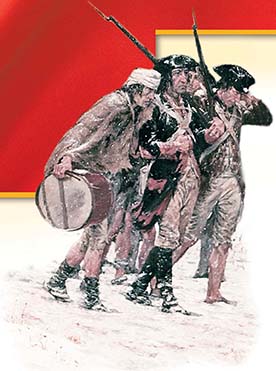SECTION 3: Turning Points of the War

Continental soldiers ►

Washington’s canteen ►
WITNESS HISTORY  AUDIO
AUDIO
Could England Win the War?
During the war, Thomas Paine wrote several pamphlets supporting the Patriot cause. Paine directed this passage to Britain’s commander, Lord Howe:
“By what means, may I ask, do you expect to conquer America? If you could not effect it in the summer, when our army was less than yours, nor in the winter, when we had none, how are you to do it? … [Y]ou have been outwitted … your advantages turn out to your loss and show us that it is in our power to ruin you…. You cannot be so insensible as not to see that we have two to one the advantage of you, because we conquer by a drawn game, and you lose by it.”
—Thomas Paine, The American Crisis II, 1777
Objectives
- Explain the advantages the British held at the start of the war and the mistakes they made by underestimating the Patriots.
- Describe the frontier war.
- Evaluate the major military turning points of the war.
Terms and People
- William Howe
- mercenary
- Battle of Trenton
- Charles Cornwallis
- Battle of Princeton
- Saratoga
- Marquis de Lafayette
- Benjamin Franklin
- Valley Forge
- Monmouth
NoteTaking
Reading Skill: Summarize Record the British and Patriot strengths and weaknesses on a chart like the one below.
| British | |
|---|---|
| Strengths | Weaknesses |
|
|
|
Why It Matters To make their independence a reality, the Patriots had to win a hard and bloody war against the world’s most powerful empire. Britain’s population was nearly four times larger than the 2.5 million people in the colonies. And at least a fifth of the colonists were Loyalists. Another fifth were slaves, who were likely to join the British to escape enslavement. Many others remained neutral for as long as possible. Section Focus Question: What factors helped the Patriots win the war?
The Opposing Sides
At the beginning of the war, Britain seemed to have great advantages. A leader in manufacturing, Britain produced more ships and weapons than the colonists did. The British also had an established government, while the Americans were starting from scratch. Meanwhile, the Continental Congress struggled to pay for the war. Lacking the authority to collect taxes, Congress and the states printed paper money to pay their debts, producing inflation that damaged the economy. The Continental soldiers suffered from hunger and cold, while the British troops were well trained and had plenty of supplies. The odds seemed slight that the Patriots could win.
The British Make Mistakes
In 1775, the British did not take the Patriots seriously as an enemy. Two months after the defeat at Concord, they repeated their mistake at the Battle of Bunker Hill. By fortifying hills overlooking Boston, the Patriots hoped to drive the British from that seaport. To retake the hills, the new British




